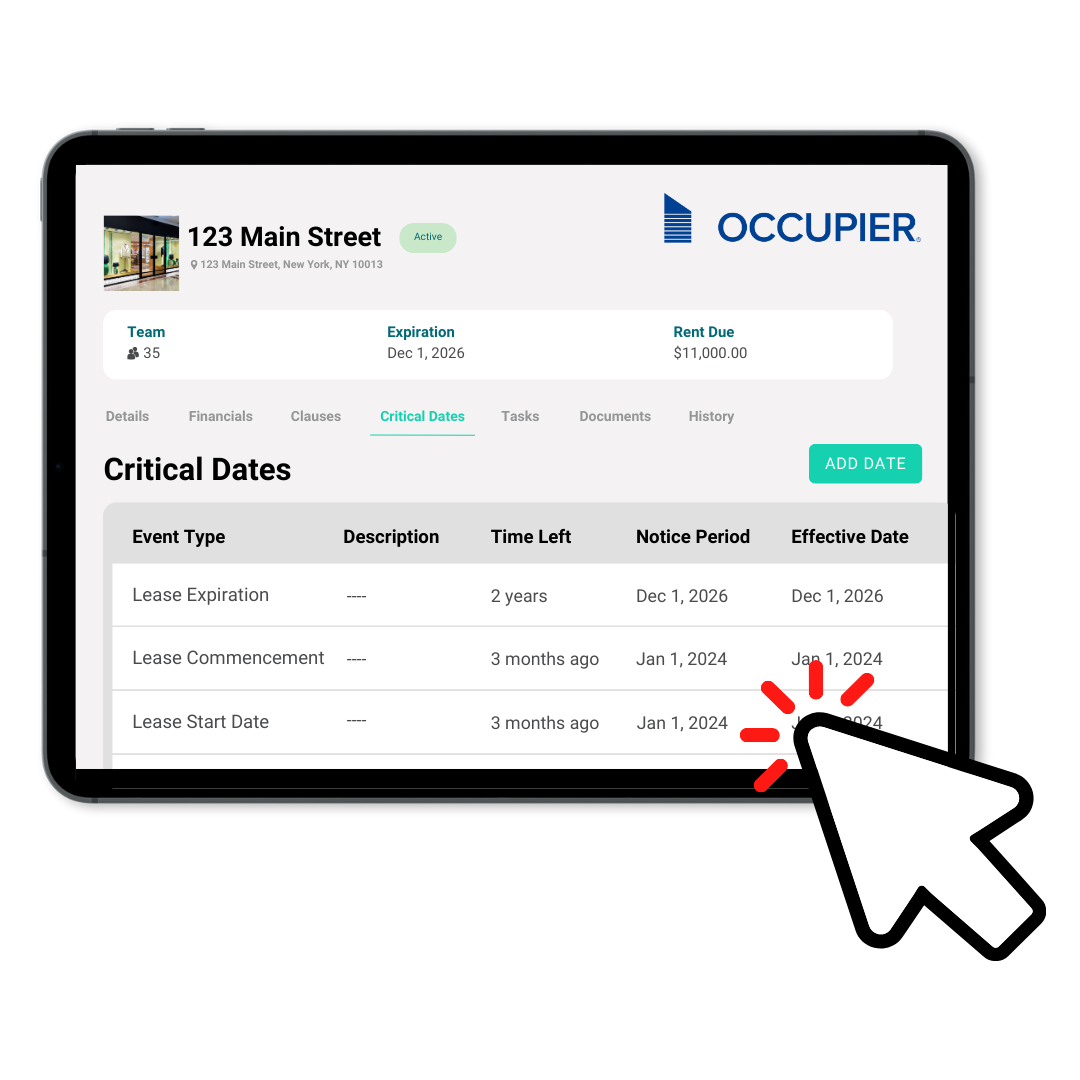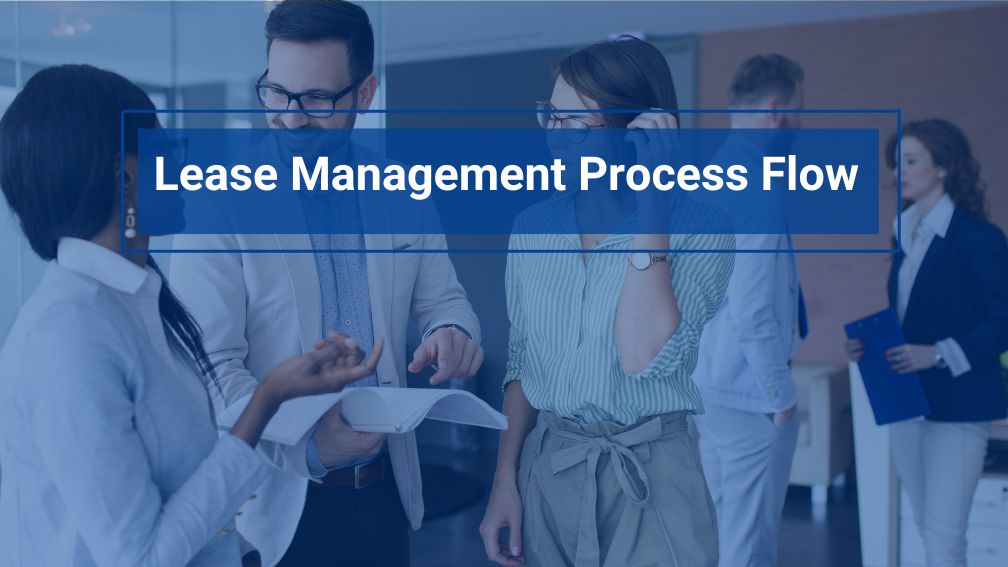Lease Management Process Flow: Efficiency, Communication, Automation
Last Updated on May 2, 2024 by Morgan Beard
For any organization leasing commercial real estate, effective lease management is critical yet complex. There are myriad details to track across the full lease lifecycle — from sourcing properties and negotiating terms to maintaining an accurate lease inventory, monitoring compliance and properly accounting for expenses. When lease administration falls through the cracks, corporations face potential financial risks, operational disruptions and compliance penalties.
Developing and adhering to lease management best practices enables companies to proactively control their lease portfolio instead of being reactive. In this guide, we’ll explore key aspects of an optimized lease management approach, focusing on establishing structured processes, promoting collaborative workflows, leveraging technology to drive efficiencies and capitalizing on portfolio data. By implementing these best practices, real estate teams can ensure leases are accurately administered in alignment with business objectives.
Overview of Lease Management
Lease management is the overarching discipline of administering every stage of the leasing process for commercial real estate portfolios. The lease lifecycle begins with strategic planning around which properties to lease based on factors like workplace strategy, market conditions, and portfolio health metrics. Once target markets and properties are identified, the transaction process involving space tours, proposals, negotiations and legal review culminates in lease execution if moving forward.
After a lease commences, the lease administration phase requires robust processes for tracking critical dates like rent payments, operating expense reconciliations, exercise periods for renewal/termination options, and other obligations and responsibilities outlined in the lease agreements. Organizations need full visibility into their leased asset inventory and remaining lease terms. As lease expirations approach, the cycle continues with the renewal/restructure or new property sourcing phase.
How to Streamline the Lease Management Process
Having a defined, repeatable process for lease management activities is a foundational best practice. An established process provides structure yet allows for flexibility based on specific scenarios. It sets clear roles and approval workflows, file management conventions, reporting cadences and process hand-offs between teams. Identify any “fuzzy areas” of the process map where there may be lack of clarity or potential for missed handoffs and improve the process accordingly.
With a solid process foundation, you can overlay tools and technologies to gain efficiency through task automation and streamlining. For instance, implement rent payment and critical date notification workflows with escalations. Facilitate seamless hand-offs between teams with technologies that support transparent assignment hand-off, communications tracking and progress visibility. Other processes that are ripe for optimization include:
- New Lease Acquisition: Define responsibilities between regional teams, corporate real estate services, legal support, IT/OT provisioning, etc.
- Lease Abstraction & Data Capture: Establish abstraction standards to accurately codify lease data and metadata into the technology systems.
- Accounting Treatment & Financial Reporting: Implement processes to ensure lease data is accurately captured, calculated and accounted for based on lease type and accounting standards.
By instituting lease management as a formal, continuously improving business process rather than antiquated one-off requests, companies benefit from repeatable high-quality execution, accuracy and risk mitigation.
Effective Collaborative Workflows in Lease Management
Given the cross-functional stakeholders involved — corporate real estate, finance/accounting, legal teams, business units, executives and more — lease management absolutely requires seamless collaboration. Complex transactions and non-integrated processes requiring constant hand-offs create contractual risk if communications break down between teams.
Cloud-based technology platforms purpose-built for lease management software automations can facilitate stakeholder collaboration through centralized document repositories, shared workspaces and structured communication flows. Automated notifications keep all players informed on critical dates and the pending responsibilities of other stakeholders.
In addition to systems facilitating shared workspaces, organizational change management is key to promoting effective collaboration around leases. Fostering a culture of open communication, visibility and shared accountability between real estate, legal, finance and business units is paramount. Some ways to drive this:
Establish a formal real estate and finance accounting committee providing collective oversight and decision-making over leases
- Conduct regular lease portfolio/pipeline meetings and retrospectives across companies
- Provide corporate training on leases from legal, tax and accounting perspectives
- Develop centers of excellence for leasing process, technology and change management
- Leverage reporting and dashboards so all teams stay synchronized on the complete lease picture
At the end of the day, leases impact various business units and functions, so collaborative teaming should be embedded into the DNA of your lease management culture.
Utilizing Technology for Process Automation
Spreadsheets and emails alone are wholly insufficient for scaling lease management. There are too many moving parts and manual steps to maintain control. When your lease portfolio reaches 10 or 12 leases with multiple departments collaborating on the portfolio management pieces, it becomes risky to leave these agreements in PDF or Excel file. Purpose-built real estate technology provides the capabilities to systematize and optimize lease management processes:
- Workflow Automation: From quick email notifications to multistep approval processes, automated tasks based on lease metadata like contract dates, responsibility matrices, document linking and dynamic condition logic. Stakeholders get proactively notified based on their responsibilities without manually checking spreadsheets.
- Digital Document Management: A centralized repository for document storage with version tracking and links to related leases/documents accelerates retrieving information on an as-needed basis.
- Portfolio Visibility: Dynamic reporting and dashboards give stakeholders real-time visibility into decentralized portfolios including critical dates, obligations, occupancy costs and more.
- Audit Trails & Compliance: Capture comprehensive audit trails to prove process compliance, evaluate bottlenecks and implement continuous improvement initiatives.
- Systems Integration: Leverage pre-built API connectors and integration tools to sync lease portfolio data with CRE management applications, ERPs, accounting software and more. Integrate with e-signature, OCR and AI tools.
- Multi-Party Access: Provide secure access based on roles/permissions and collaborate transparently with outside parties like tenant-rep brokers, legal partners and operations vendors.
In evaluating lease administration software solutions, it’s important to examine the depth of process automation capabilities in addition to feature parity and the intuitive usability for a wide range of stakeholders. Both real estate and equipment leases require a compressive review process. So, leveraging a lease management process flow that prioritized a centralized records’ system to mitigate data integrity problems and that includes global accounting compliance standard practices is mission-critical to your business.
Leveraging Data and Analytics
When executed effectively, the lease management process generates large volumes of strategic data — rental amounts, security deposit requirements, maintenance costs, termination option fees, operating expenses, rent commencement dates, lease expirations and more. By capturing this lease abstraction data in a central system and ensuring high data quality, this “lease data Lake” becomes invaluable for analytics to power decision-making.
Some key lease lifecycle areas real estate teams explore:
Lease Accounting: Comply with FASB/IASB regulations in classifying leases, addressing embedded leases, tracking and calculation adjustments and modifications with real-time visibility into lease liabilities and ROU assets. Accounting accuracy is key for your finance team to ensure your organization passes their lease administration audit. These accounting standards impact financial statements, including the income statement, balance sheet and cash flow statement.
Occupancy Cost Management: Analyze occupancy costs per square foot, per employee, per region or any other lens to identify cost optimization and negotiation opportunities.
Facilities Management: By closely aligning lease administration and facilities management processes, organizations can optimize service request workflows, preventative maintenance schedules, vendor management and sustainability initiatives across their leased portfolio.
Lease vs. Buy Analysis: Model out leasing scenarios against the costs of buying property given interest rates, maintenance, hiring needs and construction costs per market.
Scenario Modeling: Test out different assumptions like growth plans, market performance, competitive dynamics, space usage projections and more to proactively adjust real estate supply/demand plans.
CAM Reconciliations: For tenants, diligent CAM (common area maintenance) reconciliation processes are crucial to validating operating expense calculations from landlords and avoid overpaying.
Transaction Management: Surface recommendations around lease renewals, relocations, consolidations and dispositions based on empirical real estate data.
By continuously improving data quality and layering in additional contextual data from workplace sensors, the insights real estate teams can generate become increasingly robust. It takes a coordinated effort between real estate, development, workplace, operations as well as finance and accounting teams to really gain a comprehensive view of your lease portfolio.
The Path to Lease Management Process Excellence
Organizing your lease management process workflows starts with having dedicated personnel to the mission of updating manual processes. Too many times, fragmented workflows, compliance requirements and financial complexities, repetitive administrative tasks create significant challenges for organizations with large lease portfolios. By embracing essential practices around structured processes, fostering collaboration, leveraging technology enablers and data-driven decision-making, corporations can mitigate risks and realize dollar savings in their lease portfolios. Pursue continuous improvement on your path to lease management excellence and reap the benefits of optimizing one of your largest capital expense items.

Product Tour
Take a self-guided tour and see how the fastest-growing commercial tenants leverage Occupier for lease management & lease accounting.
